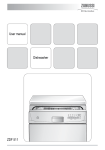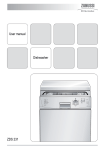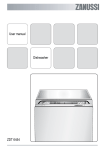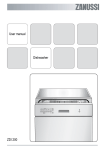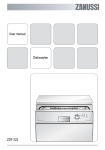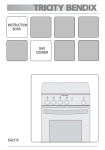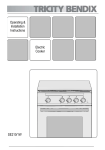Download Electrolux FAVORIT 50871 User's Manual
Transcript
FAVORIT 50871
User manual
Dishwasher
2
Dear Customer
Thank you for choosing one of our high-quality products.
With this appliance you will experience the perfect combination of functional design and cutting edge technology.
Convince yourself that our appliances are engineered to deliver the best performance and control - indeed we are setting the highest standards of excellence.
In addition to this you find environmental and energy saving aspects as an integral
part of our products.
To ensure optimal and regular performance of your appliance please read this
instruction manual carefully. It will enable you to navigate all processes perfectly
and most efficiently. To refer to this manual any time you need to, we recommend
you to keep it in a safe place. And please pass it to any future owner of the appliance.
We wish you much joy with your new appliance.
The following symbols are used in this user manual:
Important information concerning your personal safety and information on how
to avoid damaging the appliance.
General information and tips
Environmental information
Contents
3
117987850-01-09032007
Contents
Operating instructions
5
Safety information
Correct use
General safety
Child safety
Installation
5
5
6
6
6
Product description
8
Control panel
Setting mode
10
11
First use
12
Set the water softener
Setting manually
Setting electronically
12
13
13
Filling with dishwasher salt
14
Filling with rinse aid
15
Adjusting the dosage of rinse aid
16
Daily use
16
Loading cutlery and dishes
The lower basket
The cutlery basket
The upper basket
Adjusting the height of the upper basket
16
18
18
19
20
Use of detergent
Fill with detergent
Multi-tab function
Activation/deactivation of the Multi-Tab function
21
22
23
23
Washing programmes
25
Select and start a washing programme
26
Unloading the dishwasher
27
4
Contents
Care and cleaning
Cleaning the filters
Cleaning the spray arms
External cleaning
Internal cleaning
Prolonged periods of non-operation
Frost precautions
Moving the machine
28
28
29
29
29
30
30
30
Something not working
30
Technical data
33
Hints for test institutes
33
Installation instructions
35
Installation
Fitting under a counter (kitchen worktop or sink)
Levelling
Water supply connections
Water inlet hose with safety valve
Water outlet hose connection
Electrical connection
35
35
36
36
37
38
39
Environment concerns
Packaging material
39
39
Guarantee/Customer Service
Guarantee/Customer Service
European Guarantee
www.electrolux.com
41
41
42
43
Safety information
5
Operating instructions
Safety information
In the interest of your safety and to ensure the correct use, before installing and
first using the appliance, read this user manual carefully, including its hints and
warnings. To avoid unnecessary mistakes and accidents, it is important to ensure
that all people using the appliance are thoroughly familiar with its operation and
safety features. Save these instructions and make sure that they remain with the
appliance if it is moved or sold, so that everyone using it through its life will be
properly informed on appliance use and safety.
Correct use
• This dishwasher is only intended for washing household utensils suitable for
machine washing.
• Do not put any solvents in the dishwasher. This could cause an explosion.
• Knives and other items with sharp points must be loaded in the cutlery basket
with their points down or placed in a horizontal position in the upper basket.
• Only use products (detergent, salt and rinse aid) suitable for dishwashers.
• Avoid opening the door whilst the appliance is in operation, hot steam may
escape.
• Do not take any dishes out of the dishwasher before the end of the dishwashing
cycle.
• After use, isolate the appliance from the power supply and turn off the water
supply.
• This product should be serviced only by an authorised service engineer, and only
genuine spare parts should be used.
• Under no circumstances should you attempt to repair the machine yourself.
Repairs carried out by inexperienced persons will cause injury or serious malfunctioning. Contact your local Service Force Centre. Always insist on genuine
spare parts.
6
Safety information
General safety
• Dishwasher detergents can cause chemical burns to eyes, mouth and throat.
Could endanger life! Comply with the safety instructions of the dishwasher detergent manufacturer.
• The water in your dishwasher is not for drinking. Detergent residues may still be
present in your machine.
• Ensure that the door of the dishwasher is always closed when it is not being
loaded or unloaded. In this way you will avoid anybody tripping over the open
door and hurting themselves.
• Do not sit or stand on the open door.
Child safety
• This appliance is designed to be operated by adults. Don’t allow children to use
the dishwasher unsupervised.
• Keep all packaging well away from children. There is risk of suffocation.
• Keep all detergents in a safe place out of children’s reach.
• Keep children well away from the dishwasher when the door is open.
Installation
• Check your dishwasher for any transport damage. Never connect a damaged
machine. If your dishwasher is damaged contact your supplier.
• All packaging must be removed before use.
• Any electrical and plumbing work required to install this appliance must be
carried out by a qualified and competent person.
• For safety reasons it is dangerous to alter the specifications or attempt to modify
this product in any way.
• Never use the dishwasher if the electrical supply cable and water hoses are
damaged; or if the control panel, work top or plinth area are damaged such that
the inside of the appliance is freely accessible. Contact your local Service Force
centre, in order to avoid hazard.
• All sides of the dishwasher must never be drilled to prevent damage to hydraulic
and electric components.
Safety information
7
WARNING!
For electrical and water connection carefully follow the instructions given in specific paragraphs.
8
Product description
Product description
1
2
3
4
5
6
7
8
9
10
Upper basket
Water hardness dial
Salt container
Detergent dispenser
Rinse aid dispenser
Rating plate
Filters
Lower spray arm
Upper spray arm
Worktop
Product description
9
This dishwasher has an internal light that turns on and off when the opening and
closing of the dishwasher's door occurs.
Internal light is equipped with led lamp CLASS 1 in accordance with EN 60825-1:
1994 + A1: 2002 + A2: 2001.
In case that this light has to be replaced, please, contact your local Service Force
Centre.
10
Control panel
Control panel
1
2
3
4
5
6
On/off button
Programme selection buttons
Delay start button
Indicator lights
Digital display
Function buttons
Indicator lights
Programme in progress
Illuminates when a washing programme is set
and remains illuminated for all the duration of
the washing programme.
MULTITAB
Indicates the activation/deactivation of the
Multi-tab function (see Multi-tab function)
Salt
Illuminates when the special salt has run out.
1)
Control panel
11
Indicator lights
Rinse aid
Illuminates when the rinse aid has run out. 1)
1) The salt and rinse aid indicator lights are never illuminated while a washing programme is running even if filling
with salt and/or rinse aid is necessary.
Function buttons
In addition to the programme selection, the setting of the water softener and the
activation/deactivation of the rinse aid dispenser can also be set with the help of
these buttons.
The digital display indicates:
• the level of hardness to which the water softener is set,
• the approximate remaining time of the running programme,
• activation/deactivation of the rinse aid dispenser (ONLY with Multi-tab function
active),
• the end of a washing programme (a zero will appear in the digital display),
• the countdown of the delay start,
• fault codes concerning malfunction of the dishwasher.
Setting mode
The appliance is in setting mode when all programme lights are illuminated.
Always remember that when performing operations such as:
• selecting a washing programme
• setting the water softener
• activating/deactivating the rinse aid dispenser
the appliance MUST be in setting mode.
If a programme light is illuminated, the last performed programme is still set.
In this case, to return to setting mode, the programme has to be cancelled.
To cancel a set programme or a programme in progress: simultaneously press
and hold the two programme buttons positioned over the word RESET, until all the
programme button lights will illuminate. The programme has been cancelled and
the machine is now in setting mode.
12
First use
First use
Before using your dishwasher for the first time:
• Ensure that the electrical and water connections comply with the installation
instructions
• Remove all packaging from inside the appliance
• Set the water softener
• Pour 1 litre of water inside the salt container and then fill with dishwasher salt
• Fill the rinse aid dispenser
If you want to use combi detergent tablets such as: "3 in 1", "4 in 1", "5 in 1" etc...
set the Multi-tab function (see "Multi-tab function").
Set the water softener
The dishwasher is equipped with a water softener designed to remove minerals and
salts from the water supply, which would have a detrimental or adverse effect on
the operation of the appliance.
The higher the content of these minerals and salts, the harder your water is. Water
hardness is measured in equivalent scales, Clarke degrees, French degrees (°TH) and
mmol/l (millimol per litre - international unit for the hardness of water).
The softener should be adjusted according to the hardness of the water in your
area. Your local Water Authority can advise you on the hardness of the water in
your area.
The water softener must be set in both ways: manually, using the water hardness
dial and electronically.
Water hardness
Clarke
Adjusting the water hardness
setting
manually
Use of salt
°TH
mmol/l
electronically
64 - 88
91 - 125
9,1 - 12,5
2
level 10
yes
53 - 63
76 - 90
7,6 - 8,9
2
level 9
yes
46 - 52
65 - 75
6,51 - 7,5
2
level 8
yes
36 - 45
51 - 64
5,1 - 6,4
2
level 7
yes
28 - 35
40 - 50
4,0 - 5,0
2
level 6
yes
Set the water softener
Water hardness
Clarke
°TH
Adjusting the water hardness
setting
mmol/l
manually
13
Use of salt
electronically
23 - 27
33 - 39
3,3 - 3,9
2
level 5
yes
18 - 22
26 - 32
2,61 - 3,2
1
level 4
yes
13 - 17
19 - 25
1,9 - 2,5
1
level 3
yes
5 - 12
7 - 18
0,71 - 1,8
1
level 2
yes
<5
<7
< 0,7
1
level 1
no
The water softener must be set in both ways: manually, using the water hardness
dial and electronically.
Setting manually
The dishwasher is factory set at position 2.
1. Open the dishwasher door.
2. Remove the lower basket from the
dishwasher.
3. Turn the water hardness dial to position 1 or 2 (see table).
4. Replace the lower basket.
Setting electronically
The dishwasher is factory set at level 5.
1. Press the On/Off button. The dishwasher must be in setting mode.
2. Press simultaneously and keep pressed buttons B and C, until the lights of
buttons A, B and C start flashing.
3. Press button A, the lights of buttons B and C turn off while the light of button
A goes on flashing. In the digital display is visible the current level.
Examples:
displayed = level 5
displayed = level 10
14
Filling with dishwasher salt
4. To change the level, press button A. Each time the button is pressed the level
changes. (For the selection of the new level see the chart)..
Examples: if the current level is 5, by pressing button A once, level 6 is selected.
if the current level is 10, by pressing button A once, level 1 is selected.
5. To memorise the operation, switch off the dishwasher by pressing the On/Off
button.
Filling with dishwasher salt
WARNING!
Only use salt specifically designed for use in dishwashers. All other types of salt not
specifically designed for use in a dishwasher, especially table salt, will damage the
water softener. Only fill with salt just before starting one of the complete washing
programmes. This will prevent any grains of salt or salty water, which may have
been spilt, remaining on the bottom of the machine for any period of time, which
may cause corrosion.
To fill:
1. Open the door, remove the lower basket and unscrew the cap of the salt container by turning it anticlockwise.
2. Pour 1 litre of water inside the container (this is necessary only before filling
with salt for the first time) .
3. Using the funnel provided, pour in
the salt until the container is full.
4. Replace the cap making sure that
there is no trace of salt on the screw
thread or on the gasket.
5. Replace the cap tightly turning it
clockwise until it stops with a click.
Do not worry if water overflows from the
unit when filling with salt, this is quite
normal.
The salt indicator light on the control panel can remain illuminated for 2-6 hours
after the salt has been replenished, assuming the dishwasher remains switched on.
If you are using salts that take longer to dissolve then this can take longer. The
function of the machine is not affected.
Filling with rinse aid
15
Filling with rinse aid
WARNING!
Only use branded rinse aid for dishwashers.
Never fill the rinse aid dispenser with any other substances (e.g. dishwasher cleaning agent, liquid detergent). This would damage the appliance.
Rinse aid ensures thorough rinsing, and spot and streak free drying.
Rinse aid is automatically added during the last rinse.
1. Open the container by pressing the
release button (A).
2. Add the rinse aid in the container. The
maximum level for filling is indicated
by "max".
The dispenser holds about 110 ml of
rinse aid, which is sufficient for between 16 and 40 dishwashing cycles,
depending upon the dosage setting.
3. Ensure that the lid is closed after every
refill.
Clean up any rinse aid spilt during filling
with an absorbent cloth to avoid excess
foaming during the next wash.
16
Adjusting the dosage of rinse aid
Adjusting the dosage of rinse aid
According to the finish and drying results obtained, adjust the dose of rinse aid by
means of the 6 position selector (position 1= minimum dosage, position 6= maximum dosage).
The dose is factory set in position 4.
Increase the dose if there are drops of water
or lime spots on the dishes after washing.
Reduce it if there are sticky whitish streaks on
the dishes or a bluish film on glassware or
knife blades.
Daily use
•
•
•
•
•
Check if it's necessary to refill with dishwasher salt or rinse aid.
Load cutlery and dishes into the dishwasher.
Fill with dishwasher detergent.
Select a wash programme suitable for the cutlery and dishes.
Start the wash programme.
Loading cutlery and dishes
Sponges, household cloths and any object that can absorb water may not be washed
in the dishwasher.
• Before loading the dishes, you should:
– Remove all left over food and debris.
– Soften remnants of burnt food in pans
Loading cutlery and dishes
17
• When loading the dishes and cutlery, please note:
– Dishes and cutlery must not impede the rotation of the spray arms.
– Load hollow items such as cups, glasses, pans, etc. with the opening downwards so that water cannot collect in the container or a deep base.
– Dishes and items of cutlery must not lie inside one another, or cover each
other.
– To avoid damage to glasses, they must not touch.
– Lay small objects in the cutlery basket.
• Plastic items and pans with non stick coatings have a tendency to retain water
drops; these items will not dry as well as porcelain and steel items.
• Light items (plastic bowls etc.) must be loaded in the upper basket and arranged
so they do not move.
For washing in the dishwasher the following cutlery and dishes
are not suitable:
are of limited suitability:
• Cutlery with wooden, horn, china or motherof-pearls handles.
• Plastic items that are not heat resistant.
• Older cutlery with glued parts that are not
temperature resistant.
• Bonded cutlery items or dishes.
• Pewter or copper items.
• Lead crystal glass.
• Steel items prone to rusting.
• Wooden platters.
• Items made from synthetics fibres.
• Only wash stoneware in the dishwasher if it
is specially marked as being dishwasher-safe
by the manufacturer.
• Glazed patterns may fade if machine washed
frequently.
• Silver and aluminium parts have a tendency
to discolour during washing: Residues, e.g.
egg white, egg yolk and mustard often cause
discolouring and staining on silver. Therefore
always clean left-overs from silver immediately, if it is not to be washed straight after
use.
Open the door and slide out the baskets to load the dishes.
18
Loading cutlery and dishes
The lower basket
Load larger and heavily soiled dishes and pans
in the lower basket.
To make it easier to load larger dishes, the 2
plate racks on the right in the lower basket
can be folded down.
The cutlery basket
WARNING!
Sharp knives and other items of cutlery with sharp edges must be laid in the cutlery
tray or in the upper basket because of the risk of injury.
Place knives, small spoons and small forks in
the cutlery tray which is in the upper basket.
Place forks and spoons that do not fit in the
cutlery tray in the cutlery basket.
To ensure that all items of cutlery in the cutlery basket can be reached by the water, you should:
Loading cutlery and dishes
1. Place the grid insert on the cutlery
basket.
2. Place forks and spoon in the cutlery
basket with their handles pointing
downwards.
For larger utensils, such as whisks,
leave off one half of the cutlery grid.
The upper basket
Load smaller, fragile crockery and long, sharp
cutlery in the upper basket.
• Arrange items of crockery on and under the
folding cup racks so that they are offset
from each other and water can reach all
items.
19
20
Loading cutlery and dishes
• The cup racks can be folded up out of the
way for tall crockery items.
• Lay or hang wine and brandy glasses in
the slots in the cup racks.
• For glasses with long stems, fold the
glass rack to the right, otherwise fold it
away to the left.
• The row of spikes on the left of the upper
basket is also in two parts and can be
folded away.
Spikes not folded away: place glasses,
mugs etc. in the upper basket.
Spikes folded away: more room for serving dishes.
Adjusting the height of the upper basket
Maximum height of the dishes in:
the upper basket
With upper basket raised
22 cm
the lower basket
30 cm
Use of detergent
21
Maximum height of the dishes in:
the upper basket
With upper basket lowered
24 cm
the lower basket
29 cm
The height of the upper basket can also be adjusted when it is loaded.
Raising / lowering the upper basket:
1. Pull out the upper basket completely.
2. Holding the upper basket by the handle, raise it as far as it will go and then
lower it vertically.
The upper basket will latch into the
lower or the upper position.
WARNING!
After loading your machine always close
the door, as an open door can be a hazard.
Before closing the door, ensure that the spray arms can rotate freely.
Use of detergent
Only use detergents specifically designed for use in dishwashers.
Please observe the manufacturer's dosing and storage recommendations as stated
on the detergent packaging.
Using no more than the correct amount of detergent contributes to reducing pollution.
22
Use of detergent
Fill with detergent
1. Open the lid.
2. Fill the detergent dispenser (1) with
detergent. The marking indicates the
dosing levels:
20 = approximately 20 g of detergent
30 = approximately 30 g of detergent.
3. All programmes with prewash need
an additional detergent dose (5/10 g)
that must be placed in the prewash
detergent chamber (2).
This detergent will take effect during
the prewash phase.
4. When using detergent tablets, place
the tablet in compartment (1)
5. Close the lid and press until it locks in
place.
Detergent tablets
Detergent tablets from different manufactures dissolve at different rates. For this
reason, some detergent tablets do not attain their full cleaning power during short
washing programmes. Therefore, please
use long washing programmes when using detergent tablets, to ensure the complete removal of detergent residuals.
Use of detergent
23
Multi-tab function
This appliance is equipped with the "Multi-Tab function", that allows the use of the
"Multi-Tab" combi detergent tablets.
These products are detergents with a combined cleaning, rinsing and salt functions.
They can also contain other different agents depending on which kind of tablets
you choose ("3 in 1", "4 in 1", "5 in 1" etc...).
Check whether these detergents are suitable for your water hardness. See the
manufacturers instructions.
This function can be selected with all washing programmes. With the selection of
this function the inflow of rinse aid and salt from each respective supply container
is automatically deactivated and also the indicator lights for salt and rinse aid are
deactivated.
Select the "Multi-Tab function " before the start of a washing programme.
Once this function is selected (indicator light illuminated) it will remain active also
for the following washing programmes.
With the use of the "Multi-Tab function", the cycle durations may change. In this
case, in the digital display, the indication of the running time of the programme is
automatically updated.
Once the programme is running, the "Multi-Tab function " can NO longer be
changed. If you want to exclude the "Multi-Tab function " you have to cancel the
programme setting and then deactivate the "Multi-Tab function ".
In this case you have to set a washing programme (and desired options) again.
Activation/deactivation of the Multi-Tab function
Press simultaneously the two buttons positioned over the Multi-Tab symbol, until
the "Multi-Tab function" indicator light illuminates. This means that the function
is active.
To deactivate the function press the same buttons again until the indicator light
corresponding to the "Multi-Tab function" symbol turns off.
24
Use of detergent
If the drying results are not satisfactory we suggest that you:
1. Fill up the rinse aid dispenser with rinse aid.
2. Activate the rinse aid dispenser.
3. Set the rinse aid dosage to position 2.
• The activation/deactivation of the rinse aid dispenser can only be possible with
the "Multi-Tab function" active.
Activation/deactivation of the rinse aid dispenser
1. Press the On/Off button. The dishwasher must be in setting mode.
2. Press simultaneously buttons B and C, until the lights of buttons A , B, and C
start flashing.
3. Press button B, the lights of buttons A and C turn off while the light of button
= Rinse
B goes on flashing. The digital display indicates the current setting:
aid dispenser deactivated.
4. To change the setting, press button B again, the digital display indicates the
= Rinse aid dispenser activated.
new setting:
5. To memorise the operation, switch off the dishwasher by pressing the On/Off
button.
If you decide to turn back to the use of standard detergent system we advise that
you:
1. Deactivate the "Multi-Tab function".
2. Fill up the salt container and the rinse aid dispenser again.
3. Adjust the water hardness setting to the highest setting and perform 1 normal
washing programme without loading any dishes.
4. Adjust the water hardness setting according to the hardness of the water in
your area.
5. Adjust the rinse aid dosage.
Washing programmes
25
Light soil
Crockery
and cutlery
INTENSIV
CARE 70°
Heavy soil
Crockery,
cutlery,
pots and
pans
ECO 50°4)
Normal
soil
Crockery
and cutlery
160
1,05
15
GLASS
Normal
soil
Delicate
crockery
and glassware
0,8-0,9
14-15
12 - 23
9
16-18
1,1- 1,5
0,9
1,5-1,7
90-115
30
140-150
1/2x
Water (litres)
30. MIN3)
Energy (kWh)
Crockery,
cutlery,
pots and
pans
Duration (minutes)
Mixed
normal
and heavy
soil
2)
Consumption values 1)
Drying
AUTOMATIC
Final rinse
Programme description
Intermediate rinse
Type of
load
Main wash
Degree of
soil
Prewash
Programme
60-70
Washing programmes
1) The consumption values are intended as a guide and depends on the pressure and the temperature of the water
and also by the variations of the power supply and the amount of dishes.
2) During the Auto washing programme the amount of soil on the dishes is determined by how cloudy the water
is. The programme duration, water and energy consumption levels can vary; this depends upon if the appliance
is fully or partially loaded and if the dishes are lightly or heavily soiled. The temperature of the water is
automatically adjusted between 50° C and 65° C.
3) Ideal for washing a partially loaded dishwasher. This is the perfect daily programme, made to meet the needs
of a family of 4 persons who only wish to load breakfast and dinner crockery and cutlery.
4) Test programme for test institutes.
26
Select and start a washing programme
Select and start a washing programme
Select the washing programme and delay start with the door slightly opened. The
start of the programme or the countdown of the delay start will occur only after
the closure of the door. Until then it is possible to modify the settings.
1. Check that the baskets have been loaded correctly and that the spray arms are
free to rotate .
2. Check that the water tap is opened.
3. Press the On/Off button: all the programme lights illuminate (setting mode).
4. Press the button corresponding to the required programme (see "Washing
programmes" chart).
When a programme has been selected the corresponding light will illuminate.
Close the dishwasher's door, the programme starts automatically.
Setting and starting the programme with "delay start"
1. After having selected the washing programme, press the delay start button
until the flashing number of hours for the delay start will appear in the digital
display. You can choose from 1 to 19 hours of delay.
2. Close the dishwasher's door, the countdown starts automatically.
The number in the display is no longer flashing but fixed with static light.
3. The countdown will decrease with steps of 1 hour.
4. The opening of the door will interrupt the countdown.
5. Once the delay start has elapsed the programme will start automatically.
With the delay start function set, the programme in progress indicator light is
off. Once the countdown of the delay start has elapsed, the washing programme
will start automatically and the programme in progress indicator light will illuminate.
The selection of the washing programme and delay start can also occur with the
door closed. Keep in mind that in this way, once a washing programme button is
pressed you have ONLY 3 seconds in which you can choose another programme
or select a delay start, after which the selected programme will start automatically.
Cancelling the "delay start" and / or a washing programme
• To cancel a delay start in progress you have to reset the dishwasher.
Unloading the dishwasher
27
• Cancelling a delay start involves also the cancelling of the washing programme
set. In this case you have to set the washing programme again. If a new washing
programme is to be selected, check that there is detergent in the detergent
dispenser.
WARNING!
Interrupt or cancel a washing programme in progress ONLY if it's absolutely necessary. Attention! Hot steam may escape when the door is opened. Open the door
carefully.
Interrupt a washing programme in progress:
• Open the dishwasher door; the programme will stop. Close the door; the programme will start from the point at which it was interrupted.
• Press the On/Off button, all lights will turn off. Press the On/Off button again;
the programme will start from the point at which it was interrupted.
End of the washing programme
• The dishwasher will automatically stop.
• The end of programme indicator light will illuminate.
• The light of the programme just ended will remain on.
• In the digital display appears a zero.
1. Switch off the dishwasher by pressing the On/Off button.
2. Open the dishwasher's door, leave it ajar and wait a few minutes before removing the dishes; in this way they will be cooler and the drying will be
improved.
Unloading the dishwasher
• Hot dishes are sensitive to knocks.
The dishes should therefore be allowed to cool down before removing from the
appliance.
• Empty the lower basket first and then the upper one; this will avoid water dripping from the upper basket onto the dishes in the lower one.
• Water may appear on the sides and the door of the dishwasher as the stainless
steel will eventually become cooler than the dishes.
28
Care and cleaning
CAUTION!
When the washing programme has finished, it is recommended that the dishwasher
is unplugged and the water tap turned off.
Care and cleaning
Cleaning the filters
The filters must be checked and cleaned from time to time. Dirty filters will degrade
the washing result.
WARNING!
Before cleaning the filters ensure that the machine is switched off.
1. Open the door, remove the lower basket.
2. The dishwasher filter system comprises a coarse filter (A), a microfilter
(B) and a flat filter. Unlock the filter
system using the handle on the microfilter, and remove the filter system.
3. Turn the handle about 1/4 a turn anticlockwise and remove the filter system.
4. Take hold of the coarse filter (A) by the
handle with the hole and remove
from the microfilter (B).
5. Clean all filters thoroughly under running water.
Care and cleaning
29
6. Remove the flat filter from the base
of the washing compartment and
clean both faces thoroughly.
7. Put the flat filter back in the base of
the washing compartment and ensure that it fits perfectly.
8. Place the coarse filter (A) in the microfilter (B) and press together.
9. Put the filter combination in place
and lock by turning the handle clockwise to the stop. During this process
ensure that the flat filter does not protrude above the base of the washing
compartment.
WARNING!
NEVER use the dishwasher without filters. Incorrect repositioning and fitting of
the filters will produce poor washing results and may result in damage to the
appliance.
Cleaning the spray arms
NEVER try to remove the spray arms.
If residues of soil have clogged the holes in the spray arms, remove them with a
cocktail stick.
External cleaning
Clean the external surfaces of the machine and control panel with a damp soft
cloth. If necessary use only neutral detergents. Never use abrasive products, scouring pads or solvent (acetone, trichloroethylene etc....).
Internal cleaning
Ensure that the seals around the door, the detergent and rinse aid dispensers are
cleaned regularly with a damp cloth.
We recommend every 3 months to run the wash programme for heavy soiled dishes
using detergent but without dishes.
30
Something not working
Prolonged periods of non-operation
If you are not using the machine for any prolonged period of time you are advised
to:
1. Unplug the appliance and then turn off the water.
2. Leave the door ajar to prevent the formation of any unpleasant smells.
3. Leave the inside of the machine clean.
Frost precautions
Avoid placing the machine in a location where the temperature is below 0°C. If this
is unavoidable, empty the machine, close the appliance door, disconnect the water
inlet pipe and empty it.
Moving the machine
If you have to move the machine (moving house etc....):
1. Unplug it.
2. Turn the water tap off.
3. Remove the water inlet and discharge hoses.
4. Pull the machine out together with the hoses.
Avoid over tilting the machine during transportation.
Something not working
The dishwasher will not start or stops during operation. Certain problems are due
to the lack of simple maintenance or oversights, which can be solved with the help
of the indications described in the chart, without calling out an engineer.
Switch off the dishwasher and carry out the following suggested corrective actions.
Something not working
Fault code and malfunction
appears in the digital display.
The dishwasher does not fill with water.
31
Possible cause and solution
• The water tap is blocked or furred with limescale.
Clean the water tap.
• The water tap is turned off. Turn the water
tap on.
• The filter (where present) in the threaded
hose fitting at the water inlet valve is
blocked.
Clean the filter in the threaded hose.
• The water inlet hose has not been correctly
laid or it is bent or squashed.
Check the water drain hose connection.
appears in the digital display.
The dishwasher will not drain.
• The sink spigot is blocked.
Clean out the sink spigot.
• The water drain hose has not been correctly
laid or it is bent or squashed.
Check the water drain hose connection.
appears in the digital display.
Anti-flood device is activated.
The programme does not start.
• Close the water tap and contact your local
Service Force Centre.
• The dishwasher’s door has not been properly
closed. Close the door.
• The main plug is not plugged in. Insert the
main plug.
• The fuse has blown out in the household fuse
box.
Replace the fuse.
• Delay start has been set.
If dishes are to be washed immediately, cancel the delay start.
Once these checks have been carried out, switch on the appliance: the programme
will continue from the point at which it was interrupted.
If the malfunction or fault code reappears contact the Service Force Centre.
For other fault codes not described in the above chart, please contact your local
Service Force Centre, quoting the model (Mod.), product number (PNC) and serial
number (S.N.).
This information can be found on the rating plate located on the side of the dishwasher door.
32
Something not working
So that you always have these numbers at hand, we recommend you to make a
note of them here:
Mod. : . . . . . . . . . . . . . . . . . . . . . . .
PNC :. . . . . . . . . . . . . . . . . . . . . . . .
S.N. : . . . . . . . . . . . . . . . . . . . . . . . .
The wash results are not satisfactory
The dishes are not clean
• The wrong washing programme has been selected.
• The dishes are arranged in such a way as to
stop water reaching all parts of the surface.
The baskets must not be overloaded.
• The spray arms do not rotate freely due to
incorrect arrangement of the load.
• The filters in the base of the washing compartment are dirty or incorrectly positioned.
• Too little or no detergent has been used.
• Where there are limescales deposits on the
dishes; the salt container is empty or the incorrect level of the water softener has been
set.
• The drain hose connection is not correct.
• The salt container cap is not properly closed.
The dishes are wet and dull
• Rinse aid was not used.
• The rinse aid dispenser is empty.
There are streaks, milky spots or a bluish coating
on glasses and dishes
• Decrease rinse aid dosing.
Water drops have dries onto glasses and dishes
• Increase rinse aid dosing.
• The detergent may be the cause. Contact the
detergent manufacturer’s consumer care
line.
If after all these checks, the problem persists, contact your local Service Force Centre.
Technical data
33
Technical data
Dimension
Width - height - depth (cm)
60 x 85 x 63,5
Electrical connection - Voltage - Overall power - Fuse
Information on the electrical connection is given on the rating
plate on the inner edge of the dishwasher's door
Water supply pressure
Minimum - Maximum (MPa)
0,05 - 0,8
Capacity
Place settings
12
Max. weight
kg
45
Hints for test institutes
Testing in accordance with EN 60704 must be carried out with appliance fully
loaded and using the test programme (see "Washing programmes").
Test in accordance with EN 50242 must be carried out when the salt container
and rinse aid dispenser have been filled with salt and rinse aid respectively and
using the test programme (see "Washing programmes").
Full load: 12 standard place settings
Amount of detergent required:
5 g + 25 g (Type B)
Rinse aid setting:
position 4 (Type III)
34
Hints for test institutes
Example loading arrangements:
Upper basket 1)
Lower basket with cutlery basket2)
Cutlery basket
1) If there are cup racks in place on the lefthand side or the cutlery tray is in place, remove them.
2) If necessary, you can remove the cup racks on the lefthand side and/or the beer glass holder.
Installation
35
Installation instructions
Installation
WARNING!
Any electrical and/or plumbing work required to install this appliance should be
carried out by a qualified electrician and/or plumber or competent person.
Remove all packaging before positioning the machine.
If possible, position the machine next to a water tap and a drain.
Fitting under a counter (kitchen worktop or sink)
By removing the machine's worktop, you can install it under a close fitting sink
unit or a pre-existing top, providing the dimensions of the recess correspond to
those shown in the picture.
Proceed as follows:
1. Remove the machine's worktop by
unscrewing the two rear retaining
screws, pull the worktop from the
back of the machine and slide out the
front slots, lifting the worktop.
2. Insert the machine after adjusting the
levelling with the adjustable feet.
36
Installation
When inserting the machine, ensure that the water inlet and drain hoses are not
kinked or squashed.
During all operations that involve accessibility to internal components the dishwasher has to be unplugged.
Be sure that once the appliance has been installed, it is easily accessible for the
service engineer in the event that a repair is required.
If the dishwasher is later used as a free-standing appliance, the original worktop
must be re-mounted.
The plinth on free-standing appliances is not adjustable.
Levelling
Good levelling is essential for correct closure and sealing of the door. When the
appliance is correctly levelled, the door will not catch on either side of the cabinet.
If the door does not close correctly, loosen or tighten the adjustable feet until the
machine is perfectly level.
Water supply connections
Connection to a cold water supply is advised. If connection is made to a hot water
supply the maximum permissible temperature is 60°C. A hot water supply is not
always efficient with very soiled crockery as it shortens the washing programmes
a lot.
For making the connection itself, the coupling nut fitted to the machine's supply
hose is designed to screw onto a 3/4" gas thread spout or to a purpose made quickcoupling tap such as the Press-block.
The water pressure must be within the limits given in the "Technical specifications".
Your local Water Authority will advise you on the average mains pressure in your
area.
The water inlet hose must not be kinked, crushed, or entangled when it is being
connected.
The dishwasher features fill and drain hoses which can be turned either to the left
or the right to suit the installation by means of the locknut.
The locknut must be correctly fitted to avoid water leaks.
(Attention! NOT all models of dishwashers have fill and drain hoses provided with
locknut. In this case, this kind of facility is not possible). If the machine is connected
Installation
37
to new pipes or pipes which have not been used for a long time, you should run
the water for a few minutes before connecting the inlet hose.
DO NOT use connection hoses which have previously been used for an old
appliance.
This appliance has been fitted with safety features which will prevent the water
used in the appliance from returning back into the drinking water system. This
appliance complies with the applicable plumbing regulations.
Water inlet hose with safety valve
After connecting the double-walled water inlet hose, the safety valve is next to the
tap. Therefore the water inlet hose is only under pressure while the water is running.
If the water inlet hose starts to leak during this operation, the safety valve cuts off
the running water.
Please take care when installing the water inlet hose:
• The electrical cable for the safety valve is in the double-walled water inlet hose.
Do not immerse the water inlet hose or the safety valve in water.
• If water inlet hose or the safety valve is damaged, remove the mains plug immediately.
• A water inlet hose with safety valve must only be replaced by a specialist or by
the Service Force Centre.
• Place the water inlet hose in such a way that it is never higher than the bottom
edge of the safety valve.
WARNING!
Warning! Dangerous voltage.
38
Installation
Water outlet hose connection
The end of the drain hose can be connected in the following ways:
1. To the sink outlet spigot, securing it to the underside of the work surface. This
will prevent waste water from the sink running into the machine.
2. To a stand pipe provided with vent-hole, minimum internal diameter 4 cm.
The waste connection must be at a height of
between 40 cm (minimum) and 85 cm (maximum) from the bottom of the dishwasher.
The drain hose can face either to the right or
left of the dishwasher.
Ensure the hose is not bent or squashed as this
could prevent or slow down the discharge of
water.
The sink plug must not be in place when the
machine is draining as this could cause the
water to syphon back into the machine.
If you use a drain hose extension it must be no longer than 2 metres and its internal
diameter must be no smaller than the diameter of the hose provided.
Likewise the internal diameter of the couplings used for connections to the waste
outlet must be no smaller than the diameter of the hose provided.
When connecting the drain hose to an under sink trap spigot, the entire plastic
membrane (A) must be removed. Failure to remove all the membrane will result
in food particles building up over time eventually blocking the dishwasher drain
hose spigot.
Our appliances are supplied with a security device to
protect against the return of dirty water back into the
machine. If the spigot of your sink has a "no return valve"
incorporated this can prevent the correct draining of
your dishwasher. We therefore advise you to remove it.
Environment concerns
39
Electrical connection
WARNING!
Safety standards require the appliance to be earthed.
Prior to using the appliance for the first time, ensure that the rated voltage and
type of supply on the rating plate match that of the supply where the appliance is
to be installed.
The fuse rating is also to be found on the rating plate.
Always plug the mains plug into a correctly installed shockproof socket. Multi-way
plugs, connectors and extension cables must not be used.
This could constitute a fire hazard through overheating.
If necessary, have the domestic wiring system socket replaced. In case that the
electrical cable has to be replaced, contact your local Service Force centre.
The plug must be accessible after the appliance has been installed.
Never unplug the appliance by pulling on the cable. Always pull the plug.
The manufacturer accepts no liability for failure to observe the above safety precautions.
Environment concerns
Packaging material
The packaging materials are environmentally friendly and can be recycled. The
plastic components are identified by markings, e.g. >PE<, >PS<, etc. Please dispose
of the packaging materials in the appropriate container at the community waste
disposal facilities.
WARNING!
When a unit is no longer being used:
• Pull the plug out of the socket.
• Cut off the cable and plug and dispose of them.
• Dispose of the door catch. This prevents children from trapping themselves inside
and endangering their lives.
40
Environment concerns
The symbol
on the product or on its packaging indicates that this product may
not be treated as household waste. Instead it should be taken to the appropriate
collection point for the recycling of electrical and electronic equipment. By ensuring this product is disposed of correctly, you will help prevent potential negative
consequences for the environment and human health, which could otherwise be
caused by inappropriate waste handling of this product. For more detailed information about recycling of this product, please contact your local council, your
household waste disposal service or the shop where you purchased the product.
41
Guarantee/Customer Service
Guarantee/Customer Service
Standard guarantee conditions
We, AEG-Electrolux , undertake that if within 12 months of the date of the purchase
this AEG-Electrolux appliance or any part thereof is proved to be defective by reason
only of faulty workmanship or materials, we will, at our option repair or replace
the same FREE OF CHARGE for labour, materials or carriage on condition that:
• The appliance has been correctly installed and used only on the electricity supply
stated on the rating plate.
• The appliance has been used for normal domestic purposes only, and in accordance with the manufacturer's instructions.
• The appliance has not been serviced, maintained, repaired, taken apart or tampered with by any person not authorised by us.
• Electrolux Service Force Centre must undertake all service work under this guarantee
• Any appliance or defective part replaced shall become the Company's property.
• This guarantee is in addition to your statutory and other legal rights.
Exclusions
• Damage or calls resulting from transportation, improper use or neglect, the replacement of any light bulbs or removable parts of glass or plastic.
• Costs incurred for calls to put right an appliance which is improperly installed
or calls to appliances outside the United Kingdom.
• Appliances found to be in use within a commercial environment, plus those
which are subject to rental agreements.
• Products of Electrolux manufacturer that are not marketed by Electrolux
Service and Spare Parts
In the event of your appliance requiring service, or if you wish to purchase spare
parts, please contact your local Service Force Centre by telephoning
0870 5 929 929
Your telephone call will be automatically routed to the Service Force Centre covering your postcode area.
For the address of your local Service Force Centre and further information about
Service Force, please visit the website at
42
www.serviceforce.co.uk
Before calling out an engineer, please ensure you have read the details under the
heading "Something not working"
When you contact the Service Force Centre you will need to give the following
details:
1. Your name, address and postcode.
2. Your telephone number.
3. Clear concise details of the fault.
4. The model and Serial number of the appliance (found on the rating plate).
5. The purchase date.
Please note a valid purchase receipt or guarantee documentation is required for in
guarantee service calls.
Customer Care
For general enquiries concerning your Electrolux appliance, or for further information on Electrolux products please contact our Customer Care Department by
letter or telephone at the address below or visit our website at www.electrolux.co.uk
Customer Care Department Electrolux Major Appliances Addington Way Luton
Bedfordshire, LU4 9QQ Tel: 08705 350 350 (*) (*) Calls may be recorded for training
purposes
European Guarantee
This appliance is guaranteed by Electrolux in each of the countries listed at the
back of this user manual, for the period specified in the appliance guarantee or
otherwise by law. If you move from one of these countries to another of the countries listed, the appliance guarantee will move with you subject to the following
qualifications:• The appliance guarantee starts from the date you first purchased the appliance
which will be evidenced by production of a valid purchase document issued by
the seller of the appliance.
• The appliance guarantee is for the same period and to the same extent for labour
and parts as exists in your new country of residence for this particular model or
range of appliances.
• The appliance guarantee is personal to the original purchaser of the appliance
and cannot be transferred to another user.
43
• The appliance is installed and used in accordance with instructions issued by
Electrolux and is only used within the home, i.e. is not used for commercial
purposes.
• The appliance is installed in accordance with all relevant regulations in force
within your new country of residence.
The provisions of this European Guarantee do not affect any of the rights granted
to you by law.
www.electrolux.com
Albania
+35 5 4 261 450
Rr. Pjeter Bogdani Nr. 7 Tirane
Belgique/België/Belgien
+32 2 363 04 44
Bergensesteenweg 719, 1502
Lembeek
Česká republika
+420 2 61 12 61 12
Budějovická 3, Praha 4,
140 21
Danmark
+45 70 11 74 00
Sjællandsgade 2, 7000 Fredericia
Deutschland
+49 180 32 26 622
Muggenhofer Str. 135, 90429
Nürnberg
Eesti
+37 2 66 50 030
Mustamäe tee 24, 10621
Tallinn
España
+34 902 11 63 88
Carretera M-300, Km. 29,900
Alcalá de Henares Madrid
France
www.electrolux.fr
Great Britain
+44 8705 929 929
Addington Way, Luton, Bedfordshire LU4 9QQ
Hellas
+30 23 10 56 19 70
4, Limnou Str., 54627 Thessaloniki
Hrvatska
+385 1 63 23 338
Slavonska avenija 3,
10000 Zagreb
Ireland
+353 1 40 90 753
Long Mile Road Dublin 12
Italia
+39 (0) 434 558500
C.so Lino Zanussi, 26 - 33080
Porcia (PN)
Latvija
+37 17 84 59 34
Kr. Barona iela 130/2,
LV-1012, Riga
44
Lietuva
+370 5 2780609
Ozo 10A, LT 08200 Vilnius
Luxembourg
+352 42 431 301
Rue de Bitbourg, 7, L-1273
Hamm
Magyarország
+36 1 252 1773
H-1142 Budapest XIV,
Erzsébet királyné útja 87
Nederland
+31 17 24 68 300
Vennootsweg 1, 2404 CG - Alphen aan den Rijn
Norge
+47 81 5 30 222
Risløkkvn. 2 , 0508 Oslo
Österreich
+43 18 66 400
Herziggasse 9, 1230 Wien
Polska
+48 22 43 47 300
ul. Kolejowa 5/7, Warszawa
Portugal
+35 12 14 40 39 39
Quinta da Fonte - Edificio
Gonçalves Zarco - Q 35
-2774-518 Paço de Arcos
Romania
+40 21 451 20 30
Str. Garii Progresului 2, S4,
040671 RO
Schweiz - Suisse - Svizzera
+41 62 88 99 111
Industriestrasse 10, CH-5506
Mägenwil
Slovenija
+38 61 24 25 731
Gerbičeva ulica 98, 1000
Ljubljana
Slovensko
+421 2 43 33 43 22
Electrolux Slovakia s.r.o.,
Electrolux Domáce spotrebiče SK, Seberíniho 1,
821 03 Bratislava
Suomi
www.electrolux.fi
Sverige
+46 (0)771 76 76 76
Electrolux Service, S:t Göransgatan 143, S-105 45 Stockholm
Türkiye
+90 21 22 93 10 25
Tarlabaşı caddesi no : 35
Taksim İstanbul
Россия
+7 095 937 7837
129090 Москва,
Олимпийский проспект,
16, БЦ "Олимпик"
45
46
47
117987850-01-09032007
Subject to change without notice
www.electrolux.com
www.aeg-electrolux.co.uk


















































